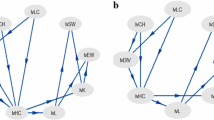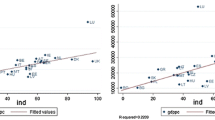Abstract
We examine the relationship between different aspects of human development and Hofstede’s six dimensions of national culture. Using multivariate regression and canonical correlation analysis, we show that all the dimensions of national culture except masculinity have a significant impact on human development, and that the overall strength of the association between the two groups of variables is a high positive one. In general, the direction of the influence of the national culture variables on economic growth differs from the manner they influence other variables, which reinforces the fact that economic growth does not always translate into true people-centred development. Furthermore, the national culture dimensions do not explain much of the variation in a number of health indicators.

Similar content being viewed by others
Notes
Note that the adolescent fertility rate, in addition to being a health variable, can also be considered as a measure of gender equality.
Collier and Levitsky (1997) discuss conceptual stretching in the context of democracy; they warn of the need to overcome the temptation to stretch the definition of democracy, because it could make its meaning unclear and cause it to be used inappropriately.
The results of all the regressions carried out under the forward selection procedure are not provided in the paper. They are available upon request.
References
Acemoglu, D. (2008). Introduction to modern economic growth. Princeton: Princeton University Press.
Aghion, P., & Howitt, P. (2009). The economics of growth (Vol. 1). Cambridge: The MIT Press.
Alkire, S. (2005). Why the capability approach? Journal of Human Development, 6(1), 115–135. doi:10.1080/146498805200034275.
Beugelsdijk, S., Maseland, R., & Hoorn, A. (2015). Are scores on Hofstede’s dimensions of national culture stable over time? A cohort analysis. Global Strategy Journal, 5(3), 223–240. doi:10.1002/gsj.1098.
Brewer, P., & Venaik, S. (2012). On the misuse of national culture dimensions. International Marketing Review, 29(6), 673–683.
Cardon, P. W., & Marshall, B. A. (2008). National culture and technology acceptance: The impact of uncertainty avoidance. Issues in Information Systems, 9(2), 103–110.
Chiang, F. (2005). A critical examination of Hofstede’s thesis and its application to international reward management. The International Journal of Human Resource Management, 16(9), 1545–1563. doi:10.1080/09585190500239044.
Clark, D. A. (2006). Elgar Companion to Development Studies Retrieved from http://QUT.eblib.com.au/patron/FullRecord.aspx?p=274933.
Collier, D., & Levitsky, S. (1997). Democracy with adjectives: Conceptual innovation in comparative research. World Politics, 49(3), 430–451. doi:10.1353/wp.1997.0009.
de Mooij, M. (2013). On the misuse and misinterpretation of dimensions of national culture. International Marketing Review, 30(3), 253–261.
Easterly, W., & Levine, R. (1997). Africa’s growth tragedy: Policies and ethnic divisions. The Quarterly Journal of Economics, 112(4), 1203.
Edward, T. (1976). Hall, Beyond Culture. New York: Anchor Books.
Eskildsen, J., Kristensen, K., & Antvor, H. G. (2010). The relationship between job satisfaction and national culture. The TQM Journal, 22(4), 369–378. doi:10.1108/17542731011053299.
Gerhart, B., & Fang, M. (2005). National culture and human resource management: Assumptions and evidence. The International Journal of Human Resource Management, 16(6), 971–986. doi:10.1080/09585190500120772.
Gong, W. (2009). National culture and global diffusion of business-to-consumer e-commerce. Cross Cultural Management: An International Journal, 16(1), 83–101.
Guiso, L., Sapienza, P., & Zingales, L. (2006). Does culture affect economic outcomes? The Journal of Economic Perspectives, 20(2), 23–48. doi:10.1257/jep.20.2.23.
Hair, J. F. (2010). Multivariate data analysis. Englewood Cliffs NJ: Prentice Hall.
Haq, M. U. (2003). The human development paradigm. In S. Fukuda-Parr & A. Kumar (Eds.), Readings in human development. New Delhi: Oxford University Press.
Haq, K. (2008). Amartya Sen and Mahbub ul Haq: A friendship that continues beyond life. Journal of Human Development, 9(3), 329–330. doi:10.1080/14649880802236524.
Hofstede, G. (1983). The cultural relativity of organizational practices and theories. Journal of International Business Studies, 14(2), 75–89. doi:10.1057/palgrave.jibs.8490867.
Hofstede, G. (1984). The cultural relativity of the quality of life concept. Academy of Management Review, 9(3), 389.
Hofstede, G. (2011). Dimensionalizing cultures: The Hofstede model in context. Online Readings in Psychology and Culture, 2(1), 8.
Hofstede, G., & Bond, M. H. (1988). The confucius connection: From cultural roots to economic growth. Organizational Dynamics, 16(4), 5–21.
Hofstede, G., & Minkov, M. (2010). Long- versus short-term orientation: New perspectives. Asia Pacific Business Review, 16(4), 493–504. doi:10.1080/13602381003637609.
Hofstede, G. H., Hofstede, G. J., & Minkov, M. (2010a). Cultures and organizations: Software of the mind: Intercultural cooperation and its importance for survival. New York: McGraw-Hill.
Hofstede, G. H., Hofstede, G. J., & Minkov, M. (2010b). Cultures and organizations: Software of the mind: Intercultural cooperation and its importance for survival (Vol. 3). New York: McGraw-Hill.
Inkeles, A., & Levinson, D. J. (1954). National character: The study of modal personality and sociocultural systems. Handbook of Social Psychology, 2, 977–1020.
Kahn, H. (1979). World economic development: 1979 and beyond. Boulder: Westview Press.
Kirkman, B. L., Lowe, K. B., & Gibson, C. B. (2008). A Quarter Century of Culture’s Consequences: A Review of Empirical Research Incorporating Hofstede’s Cultural Values Framework (Vol. 4, pp. III46). London: SAGE Publications Ltd.
Knack, S., & Keefer, P. (1997). Does social capital have an economic payoff? A cross-country investigation. The Quarterly Journal of Economics, 112(4), 1251–1288. doi:10.1162/003355300555475.
Konrad, E. (2012). National cultures and human development index. Psychological Topics, 21(3), 549.
McSweeney, B. (2002). Hofstede’s model of national cultural differences and their consequences: A triumph of faith-a failure of analysis. Human Relations, 55(1), 89–118. doi:10.1177/0018726702055001602.
Minkov, M. (2013a). Cross-cultural analysis: The science and art of comparing the world’s modern societies and their cultures. Thousand Oaks, CA: Sage Publications Inc.
Minkov, M. (2013b). Theoretical versus empirical perspectives. In Cross-cultural analysis: The science and art of comparing the world’s modern societies and their cultures. Thousand Oaks, CA: SAGE Publications Inc.
Minkov, M., & Hofstede, G. (2012). Hofstede’s fifth dimension: New evidence from the world values survey. Journal of Cross-Cultural Psychology, 43(1), 3–14. doi:10.1177/0022022110388567.
Montgomery, M. R., Gragnolati, M., Burke, K. A., & Paredes, E. (2000). Measuring living standards with proxy variables. Demography, 37(2), 155–174. doi:10.2307/2648118.
Onel, N., & Mukherjee, A. (2014). The effects of national culture and human development on environmental health. Environment, Development and Sustainability, 16(1), 79–101. doi:10.1007/s10668-013-9464-y.
Parsons, T., Shils, E. A., & Smelser, N. J. (1965). Toward a general theory of action: Theoretical foundations for the social sciences. Piscataway: Transaction Publishers.
Raykov, T., & Marcoulides, G. A. (2008). An introduction to applied multivariate analysis. New York: Routledge.
Rencher, A. C., & Christensen, W. F. (2012). Canonical Correlation Wiley series in probability and statistics: Methods of multivariate analysis (3rd ed. pp. 759–768).
Robeyns, I. (2005). The capability approach: A theoretical survey. Journal of Human Development, 6(1), 93–114. doi:10.1080/146498805200034266.
Sachs, J. D. (2001). Tropical underdevelopment (No. w8119). Cambridge Massachusetts: National Bureau of Economic Research.
Samuel Craig, C., & Douglas, S. P. (2006). Beyond national culture: Implications of cultural dynamics for consumer research. International Marketing Review, 23(3), 322–342. doi:10.1108/02651330610670479.
Shane, S. (1993). Cultural influences on national rates of innovation. Journal of Business Venturing, 8(1), 59–73.
Signorini, P., Wiesemes, R., & Murphy, R. (2009). Developing alternative frameworks for exploring intercultural learning: a critique of Hofstede’s cultural difference model. Teaching in Higher Education, 14(3), 253–264. doi:10.1080/13562510902898825.
Sims, R. L., Gong, B., & Ruppel, C. P. (2012). A contingency theory of corruption: The effect of human development and national culture. The Social Science Journal, 49(1), 90–97. doi:10.1016/j.soscij.2011.07.005.
Steenkamp, J.-B. E. M. (2001). The role of national culture in international marketing research. International Marketing Review, 18(1), 30–44. doi:10.1108/02651330110381970.
Steensma, H. K., Marino, L., Weaver, K. M., & Dickson, P. H. (2000). The influence of national culture on the formation of technology alliances by entrepreneurial firms. Academy of Management Journal, 43(5), 951–973.
Sweeney, E. P., & Hardaker, G. (1994). The importance of organizational and national culture. European Business Review, 94(5), 3–14. doi:10.1108/09555349410068830.
Taylor, M. Z., & Wilson, S. (2012). Does culture still matter?: The effects of individualism on national innovation rates. Journal of Business Venturing, 27(2), 234–247. doi:10.1016/j.jbusvent.2010.10.001.
Thompson, B. (1984). Canonical correlation analysis: uses and interpretation (Vol. 07-047). Beverly Hills: Sage Publications.
Timm, N. H. (2002). Applied multivariate analysis. Secaucus, NJ: Springer.
Trompenaars, F. (2011). Riding the waves of culture: Understanding diversity in global business. London: Nicholas Brealey Publishing.
Weber, M. (1930). The protestant ethic and the spirit of capitalism. London: Unwin University Books.
Zak, P. J., & Knack, S. (2001). Trust and growth. The Economic Journal, 111(470), 295–321. doi:10.1111/1468-0297.00609.
Author information
Authors and Affiliations
Corresponding author
Additional information
The author would like to thank two anonymous referees for their valuable comments.
Rights and permissions
About this article
Cite this article
Gamlath, S. Human Development and National Culture: A Multivariate Exploration. Soc Indic Res 133, 907–930 (2017). https://doi.org/10.1007/s11205-016-1396-0
Accepted:
Published:
Issue Date:
DOI: https://doi.org/10.1007/s11205-016-1396-0




